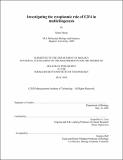Investigating the cytoplasmic role of E2F4 in multiciliogenesis
Author(s)
Hazan, Renin.
Download1191837381-MIT.pdf (2.790Mb)
Other Contributors
Massachusetts Institute of Technology. Department of Biology.
Advisor
Jacqueline A. Lees.
Terms of use
Metadata
Show full item recordAbstract
The E2F family of transcription factors plays essential transcriptional roles in many cellular processes including proliferation and terminal differentiation. Transgenic mouse models have established that E2F4 is necessary for multiciliogenesis in the airway epithelia. Here we show that E2F4 plays two distinct roles in multiciliogenesis. In early stages, it functions in the nucleus to transcriptionally activate centriole biogenesis genes required for cilia formation. Subsequently, E2F4 locates to the cytoplasm and colocalizes with the early components of deuterosome complexes, which enable the large-scale amplification of basal bodies, from which cilia are assembled. Reconstitution experiments using E2f4-deficient tracheal precursor cells in an in vitro differentiation assay, showed that both nuclear and cytoplasmic forms of E2F4 are essential for multiciliogenesis. Our biochemical analyses showed that E2F4 associates with two distinct components of the deuterosome complex, Deup1 and SAS6. We found that these proteins use distinct motifs to interact with E2F4, a coiled coil domain in Deup1 and the pisa domain/motif II in SAS6. However, the same amino terminal region of E2F4, residues 1-197, is necessary and sufficient to bind both Deup1 and SAS6. Importantly, in vitro reconstitution and differentiation experiments showed that E2F4¹⁻¹⁹⁷ is sufficient to perform E2F4's cytoplasmic role in multiciliogenesis. The previously reported redundancy between E2F4 and E2F5 in multiciliogenesis led us to investigate whether other E2Fs associate with the deuterosome components. This showed that Deup1 and SAS6 also associate with E2F5, but not E2F1. Guided by the crystal structure of E2F4 and protein sequence comparison, we narrowed down the Deup1 and SAS6 interaction domains within E2F4. This identified residues 48-53 of E2F4 as being of central importance in both Deup1 and SAS6 binding but not required for E2F4's interaction with its classic dimerization partner, DP1, arguing that they contribute to a specific Deup1 and SAS6 interaction motif, rather than affecting structural integrity. Taken together, these data identify a novel cytoplasmic role for E2F4 and E2F5 in the differentiation of multiciliated cells, which likely reflects interaction with core components of the deuterosome complex to enable the amplification of basal bodies, from which cilia are assembled.
Description
Thesis: Ph. D., Massachusetts Institute of Technology, Department of Biology, May, 2020 Cataloged from the official PDF of thesis. Includes bibliographical references.
Date issued
2020Department
Massachusetts Institute of Technology. Department of BiologyPublisher
Massachusetts Institute of Technology
Keywords
Biology.